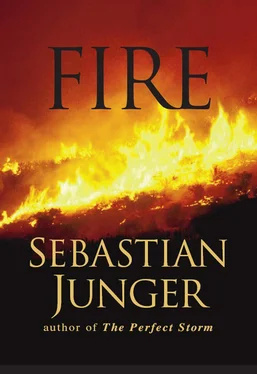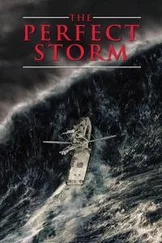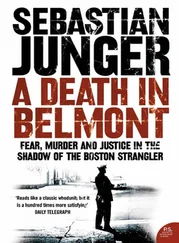Already the sun was hot, and it was going to be a long day of mop-up. Hotshots consider themselves elite, and a day spent cold-trailing—going through a burned area and putting out every ember—is not their idea of fun. It probably isn’t anybody’s idea of fun, but the type two crews get stuck doing it because by then the ’shot crews have usually been flown to some new emergency.
Today, however, the fire was not cooperating, as Casey said. Unless the wind picked up, everyone would be cold-trailing. The hotshots untaped the axes and shovels and Pulaskis that had been protected for the helicopter flight, and fueled up the chain saws—big Stihl 44s and 56s that the sawyers carried over their shoulders with a pad strapped to their suspenders—and took last swigs of water. It was hot on the ridgetop, but it was going to be ovenlike at the bottom of the valley, where the fire was burning and the wind couldn’t reach. Crew by crew, they reluctantly filed off downhill: the Helena Hotshots in their bright pink hard hats; the Flathead Hotshots; the Chief Mountain Hotshots from northern Montana, Blackfeet to a man. Casey motioned to me, and we started off down the slope, following a fire line that the type two crews had put in the day before.
A fire line doesn’t look like much: just a strip of ground scraped down to mineral soil that snakes around the perimeter of a wildfire. There are different kinds of fire line; the one we were on was called direct line, or hot line. It was several feet wide and cut right along the edge of the fire—“one foot in the black,” as they say. When the fire front is really flaming, the crews cut indirect line anywhere from a few feet to several hundred yards away. Often the area in between is then burned out with torches, called fusees. A burnout uses up the fuels between the line and the fire front, effectively creating a fire line up to several hundred yards wide. A burnout is different from a backfire, which is set deliberately to eliminate huge swaths of fuel in the path of an advancing fire. Often that is the only way to stop a crown fire that is throwing embers miles ahead of it; often, of course, a backfire becomes a disaster of its own. A burnout can be ordered by a crew boss; a backfire can be decided on only by the incident command team.
All handline—as distinguished from catline, which is cut by bulldozers—is made the same way. First, a line scout goes ahead of the crew and flags the route with red tape, taking advantage of anything—streams, rock outcrops, ridgelines—that won’t burn. The sawyers follow after the line scout, cutting everything from knee-high sagebrush to 150-foot trees. Each sawyer is assigned a swamper, who pulls the brush out of the way and throws it well outside the line. After the swampers come the rest of the crew, who use rakes, shovels, Pulaskis, and even their hands to scrape the duff clear and remove every shrub or root that crosses the fire line. Untouched forest or range enters at the beginning of this line, and a fuelless strip emerges out the other end. It is supposed to stop fire, and despite its appearance—narrow and insignificant in the midst of such huge geography—it generally does.
Fire line is built and measured in sixty-six-foot sections called chains, a unit of measurement that dates back to the early days of surveying. There are 80 chains to a mile, and hotshot crews should be able to cut 20 chains—a quarter of a mile—of fire line an hour. If it’s an emergency, the crew should be able to continue at that pace all day, all night by headlamp, and even all the next day. The unofficial record is sixty-seven hours, set by a California crew boss who had also gone thirty days without a shower. Technically both are in violation of agency policy.
For the time being the fire line served as a very good trail on the steep hillside, and I followed in Casey’s dust down toward the crews below us. Fifteen hundred feet farther down was the river. Casey’s job, as safety officer, was to walk around all day watching people work and talking to them about potential problems. Do they have a safety zone to retreat to if the fire blows up? Are people being posted as lookouts on each crew? Is everybody wearing a shirt? Most fires are slow-moving, and fighting them is closer to hoeing a garden than being in combat, but when fires blow up, they move with awesome fury, and if people aren’t prepared, they die.
“Seventy-two people were overrun at the Butte fire in ’85,” said Fred Fuller, part of the overhead team of one sort or another (“We’ve got layers upon layers of us out here,” he admitted). He was a lanky, soft-spoken man who was accompanying Casey and me on our rounds for a while. “They were in their fire shelters for an hour and a half. They lived, though—even the Cat operators who didn’t have fire shelters. They had to crawl under their machines. But they lived.”
Cat operators suffer some of the highest fatality rates on fires because they are reluctant to leave their machines until it’s too late; on the Butte fire they had to be dragged off their machines by other fire fighters. Burnovers are considered catastrophes even if no one gets killed, and the people who survive are given counseling within twenty-four hours. By all accounts they are terrifying experiences; that close, a fire storm is as loud as a jet plane taking off, and many of the people trapped in their shelters don’t even have radio communication. All they can do is wait and try not to let the convection winds tear the shelters off their backs.
Bob Root, a young severity crew foreman working downslope from us, put it bluntly: “If someone has to get into a fire shelter, then someone else fucked up. I mean, really.” Root has fought fire for seven years, since he was eighteen. He was a student at the Colorado State School of Forestry and also a member of the local sheriff’s search and rescue team. His severity crew, hired in advance because of severe fire conditions, was fire-ready around the clock and could be on their way within an hour. Root had straight straw-blond hair and a sunburn and dark Bollé glacier glasses. Realizing that I was as good an excuse for eating lunch as any, he sat down and pulled a brown paper bag out of his line pack.
“Probably the worst thing that’s happening now is what’s called urban interface—that is, houses in the forest,” he said. “When it’s a question of saving structures rather than just trees, we’re more likely to take risks. Basically, if you’re protecting a structure and the fire’s coming at you, you don’t retreat. You stay put and try to work the fire around either side.”
Root ate methodically, clearly in no hurry to resume cold-trailing. His bag lunch, delivered by helicopter, seemed geared toward the taste of grade school boys: bologna sandwiches, candy, cookies, more candy, and a couple of apples. As we talked, one of the Cromans came in low over us and started to ease itself down over the helispot. Dangling below it was a car-size bladder bag of water called a blivet. The pilot, looking down out of his side window, placed the blivet gingerly on the crest of the ridge and then released it from the tether. Root didn’t take his eyes off it.
“Sometimes when they punch off, the load goes downhill,” he explained. I realized that we were, in fact, directly below one and a half tons of water. He took a last look at it as he ate his sandwich.
“This is a pretty unexciting day, but last night was interesting. We were at the bottom of this slope—you never want to be above a fire—and rocks and trees were burning loose and just rolling past us. You could hear them coming. Someone would yell, ‘Rock!’ and then there’d be total silence while people tried to spot it and get out of the way. Logs would roll to the bottom and ignite the hillside, and the fire would come right back up at us. The night went by fast.”
Читать дальше












